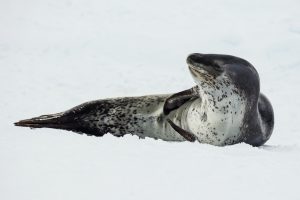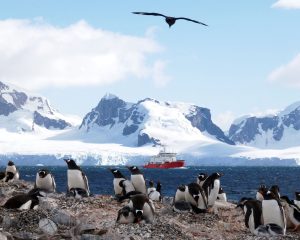When picking a topic to write about on this blog, I often turn the internet for ideas that speak to me and to see what others are discussing. Recently there have been a couple of stories circulating on the internet about a land of almost mythical proportions way, way down under. This is a place that would make even many good Canadians shiver with the prospect of facing its climate. Find your way to the very tip of South America, South Africa, and/or New Zealand and travel even further south to the frozen realm at the bottom of the world known as Antarctica.
A video has been posted on YouTube that claims to show a Google Earth image of an extraterrestrial vehicle that has slammed into the side of a mountain and then slid to its resting place on South Georgia Island in Antarctica. I am sure that many people have seen these “top weirdest things caught by Google Earth” and this is just one of the many but this photo is not as otherworldly as all that. What the photo actually shows is an avalanche of a large block of ice skidding and rolling further than the rest of the tumbling snow. If you have read any of these blogs before, you know that I am not averse to hearing such far-fetched ideas but why would anyone make up such an incredulous idea when the real Antarctica has so much about it that is beyond interesting? Where else can you find Emperor penguins, Mount Terror, and diamond dust? (note: a ground-level cloud composed of tiny ice crystals.)
It is, on average, the coldest, driest and windiest continent with the highest average elevation of all the continents. Antarctica is noted as the last discovered land on Earth; unseen until 1820 by Russian explorers and first landing to its shores by a team of Norwegians in 1895. The turn of the twentieth century saw a race to the South Pole filled with pain, triumph, death, and glory and brought the world adventurers named Amundsen, Scott, and Shackleton. It is governed by parties of a de facto condominium*; the Antarctic Treaty System regulates international relations in regards to Antarctica. It has an original 12 signatories and 53 states party to this treaty. It has prohibited all mining and military activity there; implemented a system of conservation that protects its biodiversity and prohibits any introduction of non-native species; and has designated it a “natural reserve devoted to peace and science”.
Each year sees scientists from 28 different nations conducting experiments on this continent. Antarctica attracts researchers from varying fields of science, including biologists, geologists, physicists, astronomers, glaciologists, oceanographers, and meteorologists because much of this research is not reproducible anywhere else in the world. Summer is the best time to do much of this research and the continent’s population can increase to 4000 people during these months (from about 1000 in the winter). Scientific research in Antarctica has global significance to the future of our planet and is a barometer of climate change. It also helps in our understanding of environmental issues such as ozone depletion and rising sea levels.

Leopard Seal, Antarctica
Source: Andrew Shiva (Wikimedia Commons)
In July of 2017, a huge iceberg the size of the state of Delaware broke off the Larsen C Ice Shelf after months of will it or won’t it. Now for some characteristics regarding this behemoth: this represented approximately 10% of the ice shelf from which it calved; it is about 190 metres thick with only 30 metres of it sitting above the surface of the sea; as this chunk broke away it exposed the sea below that had not seen the light for possibly 120, 000 years. Because of this, an urgent expedition was sent out to investigate this unseen ecosystem before the sunlight and the elements have had the time to alter it. A team of scientists, led by the British Antarctic Survey (BAS) headed towards this ice shelf on February 21 onboard the research vessel RRS James Clark Ross for a three week period. The team is made up of international researchers from nine different institutes and they planned to collect seafloor animals, microbes, plankton, sediments, and water samples that would have previously been under this ice shelf.
Weather is a fickle thing and Antarctic weather is even more fickle than most. Heavy sea ice (up to 4-5 metres thick) stood in the way of the ship and their ultimate destination and on February 28, the ship’s captain made the difficult decision to not proceed. Dr. Katrin Linse, biologist and lead investigator from BAS said, ““We knew that getting through the sea ice to reach Larsen C would be difficult. Naturally, we are disappointed not to get there but safety must come first. The captain and crew have been fantastic and pulled out all the stops to get us to the ice shelf, but our progress became too slow, with just 8kms travelled in 24 hours and we still had over 400kms to travel. Mother Nature has not been kind to us on our mission!”
Fortunately, the team had a plan B just in case something like this was to happen; it is hard to count on the cooperation of the weather in this part of the world. They will be sampling another area further north where a previous ice shelf collapse at the Prince Gustav Channel Ice Shelf and Larsen A Ice Shelf happened in 1995. They will have the opportunity to take specimens from even deeper in the sea than would have been possible at the original target, to a depth of 1000 metres. Think of all the wonderful creatures that they could find there that may never have been seen before.
The researchers are already planning another trip to Larsen C Ice Shelf for 2019. Hopefully, Mother Nature will allow them to do so. –Janice Willson

HMS Endurance, a Royal Navy Ice Patrol, patrolling the waters of Antarctica.
Source: Kelly Whybrow, Defense Imagery UK
Take a look at some of the beautiful photographs taken of the underwater world surrounding the Antarctic: https://www.theguardian.com/environment/2018/feb/10/first-images-of-creatures-from-antarctic-depths-revealed
References:
https://en.wikipedia.org/wiki/Antarctica
https://discoveringantarctica.org.uk/how-is-antarctica-governed/geopolitics/science-of-antarctica/
https://www.bas.ac.uk/
*A condominium is a territory over which two or more States jointly exercise governmental authority –Oxford Public International Law

